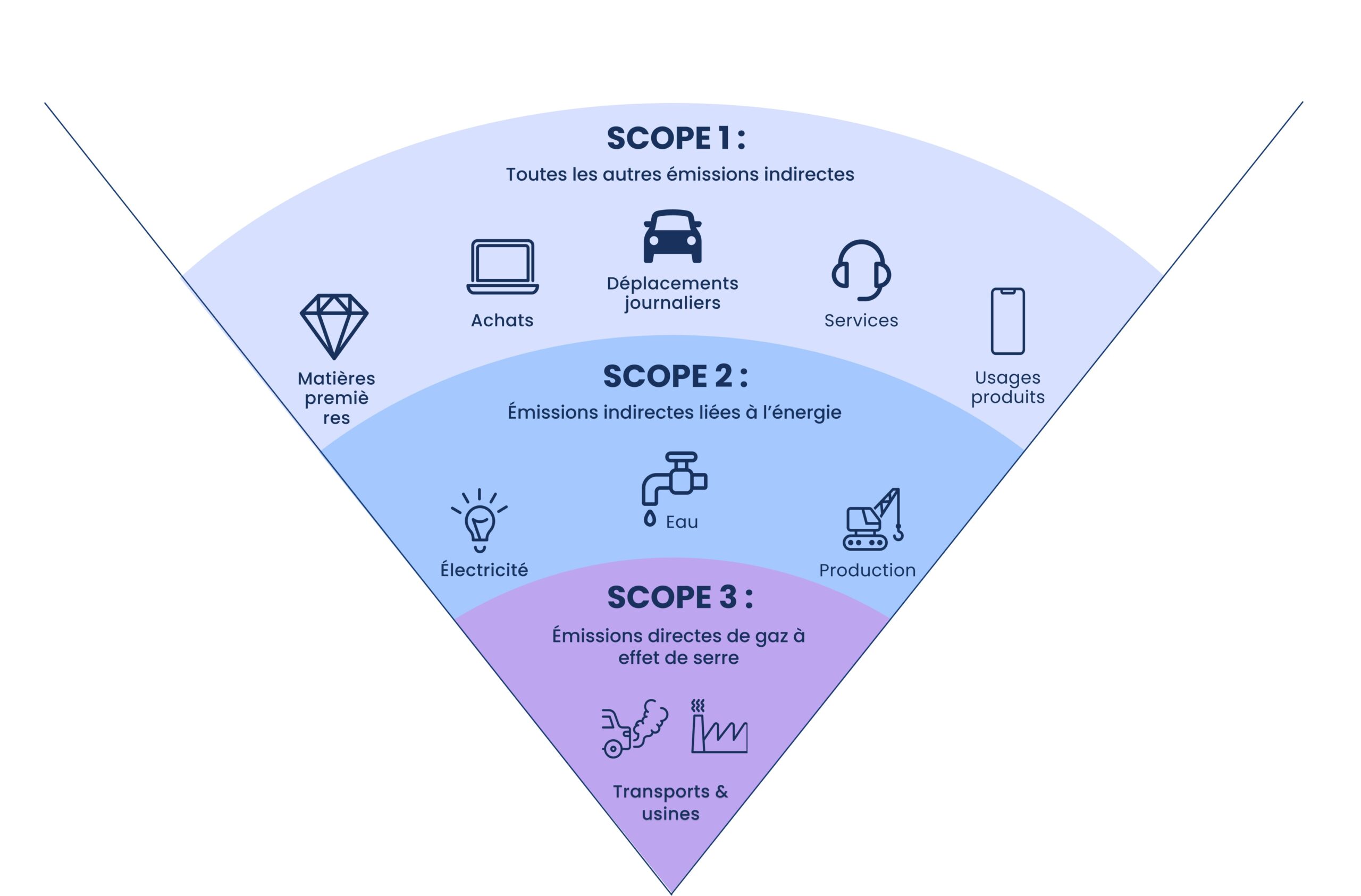Scopes 1, 2 and 3 in the carbon footprint today
Since the Paris Climate Agreement, it is no longer possible for companies to avoid the issue of measuring their carbon emissions regarding global warming. Before that, it was a non-core issue, considered operational, as it had no impact on the financial balance sheet of companies. Moreover, before the very first UN climate conference in 1992 in Rio, it was not even a topic and before 2020, companies that invested in their carbon footprint were pioneers. As measurement was neither easy nor really established in terms of protocol, a tool had to be developed to measure our greenhouse gas emissions. This is how the GHG Protocol (Greenhouse Gas Protocol) was born in 2001. It was developed by the WBSDC (World Business Council for Sustainable Development) and the WRI (World Resources Institute) and includes the measurement of the six main greenhouse gases responsible for global warming. Several international actors (governments, NGOs, etc.) have mobilized for its implementation. As a result, today, the virtue of companies is also taken into account in the measurement of economic performance ! In order to achieve a global and sustainable performance, it is therefore a key indicator of environmental performance with regard to extra-financial criteria.
The carbon footprint is considered at an international level. There are different measurement tools and some are not mandatory. That said, the best long-term strategy is to evaluate indicators according to a global approach to carbon footprinting, an approach that takes into account direct and indirect emissions, positive and negative externalities, and not only environmental but also social impacts, upstream and downstream.
The latest IPCC report shows us that the current business as usual scenario corresponds to an increase in emissions of +3.2°C above the 1990 level, whereas the initial objective set by the Kyoto Protocol (signed in December 1997) was to not exceed 1.5°C. The report states that we have failed to implement effective collective action at the global level to avoid an increase of more than 1.5°C by the middle of the century. Any delay in implementing concerted, comprehensive and anticipatory action for adaptation will cause us to miss the short window of opportunity we have left to ensure a sustainable and desirable future for all.
This means that the carbon footprint has become a strategic lever for the financial sustainability and overall performance of companies.
What is the role of scope 3 in the carbon footprint?
Contrary to certain preconceived ideas, measuring scope 3 is not simply a matter of replacing a data center with a green data center or taking into account the business travel of your employees. To explain what scope 1, 2 and 3 are, let’s take the example of a bakery.
The Corbeille à Pain bakery team is looking for a carbon footprint for its famous traditional baguette. Here is how they will measure their greenhouse gas emissions. First step: It must measure its direct emissions, the ones it emits by baking the bread with a gas oven. These are Scope 1 emissions.
Second step: It must evaluate its indirect emissions linked to electrical energy (to heat the store, or keep its famous baguettes cool). This electrical energy must be produced from so-called “primary” energy (oil, coal, gas, nuclear, renewable). These are Scope 2 emissions.
The third and last stage is not the least, since it represents the largest share of carbon emissions. It represents the indirect emissions linked to the activity of the bakery: the emissions linked to the transport of our flour, the bread deposits, the professional travel of the employees, but also the management of waste (and yes we can make bread from the day before, we also lose a little bread every day). These are Scope 3 emissions.
Why is Scope 3 so important for measuring impacts? Which categories of the GHG Protocol does it correspond to?
For the time being, the law does not require the inclusion of Scope 3, which appeared in 2011. However, it is the best way for companies to have a positive impact, in order to be carbon neutral. One could say that one of the main difficulties for companies is to assess the carbon impact on the entire value chain.
It is simple : Scope 3 takes into account carbon emissions upstream and downstream of the process. How can we measure our footprint in these 15 categories in order to enhance our positive impact? Scope 3 measures so-called indirect emissions, throughout the value chain. This is the most important part of a company’s GHG emissions. However, it is also a category of emissions calculation that can be a little more laborious to assess, particularly in the digital part.
An assessment tool to measure your digital carbon footprint
There are automated assessment tools for the environmental and social impact of companies’ digital applications that allow companies to assess Scope 3 on the use of digital applications.
Fruggr does this by assessing the energy cost and environmental impact of the hardware used by visitors to sites and apps. Depending on the time spent by the visitor, the pages consulted, the hardware used and the location, we are able to evaluate the energy cost of each visitor and then to cumulate the energy cost of all visitors so that the company knows how much it is indirectly impacting.
We also evaluate the environmental impact of the material: we know if the visitor uses a PC, a smartphone, a tablet, we know the average impact factor of manufacturing of each, we know the average life span of each type of material and we amortize the manufacturing cost in proportion to the time spent by the visitor on the site.
By basing ourselves on criteria established by several eco-design guidelines, such as the RGESN or the Bilan Carbone (ADEME 2004), it becomes possible to measure and valorize the positive impact by going a little further than the sole measurement of the carbon footprint, because in addition, Fruggr measures the social footprint and the accessibility (the two other factors taken into account in the ESG) Time well invested that allows to concretely register in a responsible digital approach to make an inclusive digital shift with positive impact.

